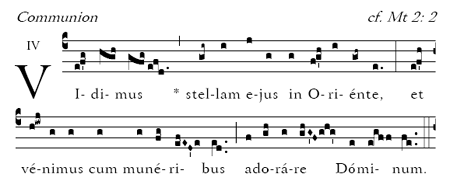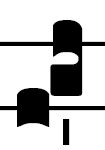Vidimus: communion for Epiphany
-
I just posted this at NLM. I hope it is not riddled with too many errors.

I can vaguely recall marveling at this communion chant for the epiphany last year, but somehow this year it has taken on an especially remarkable meaning. It is surely the most "foreign" sounding communion antiphon in the Church year. You know from the first notes that there is a mysterious search going on, and then from the second phrase with Stellam that we are looking up at the stars.
But the really interesting part takes place on the Oriente. Here we have the figure: Fa Sol La Ti Sol La Mi. Jeffrey Ostrowski pointed out to me that we have a tritone here, three successive whole notes -- the very sound of something approaching dissonance. I can imagine that a new schola, unused to modality, would be rather taken aback by this phrase.
Now, either the composer knew what Eastern music sounded like or knew how to signify the sound in music, but in either case, there is no mistaking what is being conveyed here. Even without words, you are being told a story of people on a journey looking at stars, coming from faraway lands and headed somewhere.
Many Mode IV chants sound to me like incomplete Mode I chants but here we find an archetype of a chant centered on Mi as its final. But the ear doesn't quite find it until near the end. On "Adorare Domimun" you are given a nice preparation and then placed comfortably at home on the last note, which is now indisputably the note around which the whole chant centers. You know you have arrived, and those on the journey have arrived too at their destination.
Isn't it remarkable how this small this piece can convey all that information? It is utterly and completely masterful.
Now, a quick performance note. In this piece we have two occurrences of the Salicus. It looks like a punctum attached to a podatus with an ictus on the lower note. In fact, it is a completely different figure called the Salicus.
That seeming ictus is the only place in chant that occurs the vertical episema, and it requires that the second note be expressively warmed as you move through the phrase. The salicus on Oriente is absolutely essential to making this chant achieve its full effect.
I point this out only because this is one of the stumbling blocks for new scholas. Hardly a surprise: David Hiley says its "nature is puzzling." I think we had been singing for two years before we came to understand this point. Now our chant director marks each salicus so that we won't run over them.
For further insight we turn to Dom Johner:
The first phrase moves joyously. The second breathes the spirit of adoration. Only with venimus do we perceive an echo of the joy of the first phrase. For the closing formula of the first phrase the cadence of the psalm tone of the fourth mode, b g e, served as a model. The tritone over Oriente--not so "very disturbing since a twofold b has preceded it heightens the peculiar, one might almost say the Oriental, effect of this passage. In three words the unaccented "i" of the second last syllable regularly receives melodic prominence. The fact that the common people accented the Latin language differently from the learned class may be the cause of this; without a doubt plain song was influenced considerably by this so-called "vulgar" Latin. -
One of the most important pieces of information I took away from the 2006 Colloquium is the salicus. Scott Turkington explained very well, and we rehearsed it quite a bit, in many chant pieces. Now, I realize I'm one of the few who is accompanying chant, and that Scott does not. But I feel I must comment on the salicus and the whole of the Solesmes approach. In working with the "Nova Organi Harmonia", I check through each chant comparing it to the Graduale Romanum - there are adjustments to be noted since the NOH is from the Vatican Edition rather than the Solesmes. (I also thank Jeff Ostrowski for pointing this out to me originally!) Having used this for performance for over a year now, I can usually spot each salicus without looking at the GR - certain combination of notes on certain syllables just cry for this rhythmic interpretation. Yes, the organist MUST understand both the ebb and flow of Gregorian chant!
-
Jeffrey, I am a beginner... help me find out how to distinguish between those neumes that look like a salicus and are vs. those that seem like a salicus and aren't... In looking at the piece, it seems to me that there are three instances of a salicus... at "Vidimus", "Oriente" and "et". Which one of those three is not a salicus and why? Thanks!
-
I believe that all three are salica (just guessing at the declension). A podatus has no need for a mark of ictus.
-
Thanks, Michael... I thought so, but also realize that there is so much I don't know yet, that I am hesitant to make assumptions... when it so clearly stated in the article that there were 'two' instances of a salicus, I began to doubt my understanding of it.
-
Whoops! Three. Sorry. And thanks for the point about the ictus on the podatus. i do think that this sort of this needs explaining...
-
This may seem like too much work, but when I was beginning to identify the salicus, I would consult the older manuscripts available in the Graduale Triplex. The salicus in those manuscripts is unmistakeable. It looks a little bit like this:
/
)
/
Okay, that's a bad attempt. In any case, consult Apel to see what one looks like; it's sort of like a fermata at an angle. -
You can very easily identify the salicus in st. gallen manuscript:

According to this Manuscript, you should give special attention also to both notes on syllable "ne" (in muneribus), on first two notes on syllable ri (in the same word) and on the syllable ra (adorare).
There are small melodic differences (et, cum) of small importance.
The element in the middle of salicus is called oriscus, and you can find it in other neumatic groups also. For example, oriscus is the fourth note of Introit Ecce advenit:
The images are from Mr. Stingl's site (in German only). -
Now that the Epiphany Introit has been mentioned, I was puzzling over whether the word 'et' in 'et imperium' is a salicus or not. It's a podatus followed by attached virga, with an ictus on the second note (upper note of podatus). My understanding was a salicus is a podatus preceded by punctum, with ictus on the bottom note of the podatus.
Anyone care to make the call? I don't have access to the Triplex. -
-
How about another question about interpreting neumes? When a torculus has an episema over the entire three notes, how does one sing it in practice? Does it depend upon where it falls in the phrase? Also, as in the case of the Ambrosian Gloria, with all those notes at the end with an episema, how is it sung in practice, as a ritardando?
-
I'm speaking of the torculus with episema in general and not specifically of the Ambrosian Gloria, but a reasonable interpretation of what Ted Marier did would be: double duration for the first note, 1 1/2 duration for the second and back to a tempo for the third. Still, it's a matter of expression and not a matter of arithmetic. Ted had a way of stating this interpretation in French. I guess those words were from Dom Mocquereau. Someone may recall those words.
-
It seems to quite common at the end of phrases. But I've encountered it mid-phrase also, and to great expressive advantage. I don't have my Graduale with me, but I remember an encounter with the word "accelera" imploring God to hurry and not tarry. Of the 6 notes on "-ce-", the first 3 have an episima, and the second 3 don't. I interpret it as beginning somewhat slowly, and then "accelerating" back to regular speed at the next syllable. It's quite effective.
Welcome to the MusicaSacra Forum!
To participate in the discussions on Catholic church music, sign in or register as a forum member, The forum is a project of the Church Music Association of America.
Categories
- All Discussions21,168
- General Music Discussion8,243
- Job Openings204
- Management of Music Programs851
- Choral Matters534
- Church Documents and Rubrics526
- CMAA Notes304
- Events720
- For Newcomers: Read First26
- Sacred Polyphony547
- Hymnody872
- Gregorian Chant: General2,703
- ↳ Graduale Romanum and Liber Usualis369
- ↳ Graduale Simplex60
- ↳ Semiology63
- Vernacular Plainsong696
- Anglican Use and Anglican Chant68
- Organ, Other Instruments and Repertoire435
- New Composition/Works in Progress1,295
- Recordings234
- Music for Hispanic Ministry159
- Music Education: Children211
- Music Education: General222
- News Items245
- Positions Wanted2
- General Discussion: Catholicism740
- Amusements177
- General Discussion1,035
- Opinions119

